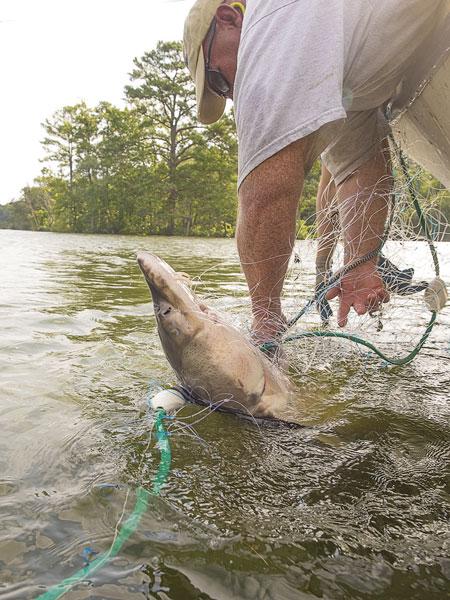
Biologists recently netted several adult sturgeon on the Marhyhope. The endangered fish were thought gone from Maryland Rivers. Dave Harp photo for Bay Journal News Service.
When a crew of biologists from the Maryland Department of Natural Resources hauled a gill net out of the Marshyhope Creek in late August, they hauled in more than the catch of the day: It may have been the catch of their careers.
One of the nets contained two “ripe” — ready to spawn — Atlantic sturgeon. One was a 7-foot 3-inch, 154-pound female. The other was a 5-foot 2-inch, 70-pound male. The female was filled with black eggs, and the male was leaking sperm.
“That was probably the most exciting and rewarding day in my career,” said Chuck Stence, head of the anadromous fish restoration unit of the DNR Fisheries Service, who was leading the survey crew. “We’re out there fishing — you’re not expecting to catch anything — and then all of sudden two fish like that get dropped into your lap.”
That catch turned out to be just the beginning. By-mid September, the crew had caught eight ready-to-spawn fish, including six males and two females on the Marshyhope, a tributary of the Nanticoke River on Maryland’s Eastern Shore. They saw several others that they weren’t able to net.
“That is pretty exciting,” said Steve Minkkinen, who heads the U.S. Fish and Wildlife Service’s Maryland Fisheries Resources Office, and has been active with sturgeon programs in the state. “There is a population of them up there. It is not just one or two random fish that showed up for some reason.”
Atlantic sturgeon are the largest fish native to the Bay, where they historically reached lengths of up to 14 feet. Once common, they suffered a dramatic population drop in the last century caused by overfishing, habitat destruction and pollution. Two years ago, the National Marine Fisheries Service listed them as an endangered species.
Like other anadromous fish, sturgeon live most of their lives in the ocean, but return to their native rivers to spawn. The James River is the only Bay tributary known to still have a spawning population. No sturgeon have been documented spawning in Maryland since 1972, when one was found in the Nanticoke River.
But the recent catches suggest the Marshyhope now has a spawning population. “I can’t imagine a fish that big going up in there for any reason other than to spawn,” Stence said.
And, like the James River, the sturgeon seem to be spawning in the fall, unlike sturgeon that spawn in rivers farther north, such as the Hudson.
“I am very surprised by that,” Minkkinen said. “All the other anadromous fish are releasing their eggs in the spring.” That’s when plankton blooms fuel the food web that helps support newly spawned fish.
Proof of successful spawning would require finding recently spawned “young of year” fish in the river. Right now, Stence said, no surveys exist in the vicinity of the Marshyhope that would catch young-of-year sturgeon. Now, with evidence that suggests likely spawning activity, the fishery service will consider starting one, he said.
It’s unknown where the sturgeon came from. They could be remnants of a native Maryland population that went undetected for decades.
It is possible, some have suggested, that they are James River fish that have wandered up the Bay.
Another possibility is that they stem from a small batch of juvenile Hudson River fish that were released in the Nanticoke in 1996.
Those questions could be answered in coming weeks. The biologists take DNA samples of each sturgeon for analysis to determine their river of origin.
Biologists would also like to know what habitats the fish are using. So the captured sturgeon were briefly anesthetized and the biologists made minor incisions in each to insert a small transmitter and a tag so they can monitor the sturgeons’ movements and identify them in the future.
After that procedure, the biologists jump into the chest-deep water and cradle the fish, “like babies,” Stence said. After about 10 minutes, the sturgeon recover and swim away.
The recent catches ended more than two years of frustration for the biologists. Fishermen have reported seeing sturgeon jumping in the Marshyhope for several years. Last fall, one landed in the boat of two anglers.
But crews from the DNR and the U.S. Fish and Wildlife Service had — until Aug. 28 — failed to catch any sturgeon. The previous week, in fact, Stence and his crew saw one jump only 40 feet from their boat, but they were unable to net it.
“It’s so frustrating when you see them jumping right in front of the boat, and you still can’t catch them,” he said.
That changed as they were pulling in the last of four, 100-yard gill nets that had been deployed on the 28th.
“We got maybe a third of the way through the net, and all of a sudden the net started pulling back,” Stence said. “And the closer we got, you could see the big shadow in the water. It’s amazing how the adrenaline kicks in when you go out there for three years and catch nothing, and all of a sudden you can see a big one in the net — and then having another one right behind it.”
By Karl Blankenship
Bay Journal News Service
Distributed by Bay Journal News Service.



Carol Brown says
What a nice story about a wonderful happening!